Museums
The seven major museums that are managed by the Department are the Hong Kong Museum of Art, Hong Kong Museum of History, Hong Kong Museum of Coastal Defence, Hong Kong Science Museum, Hong Kong Space Museum, Hong Kong Heritage Museum and Dr Sun Yat-sen Museum. In the interests of study, education and enjoyment, the museums acquire, conserve, research, exhibit and interpret tangible and intangible cultural heritage.
The Department also manages the Hong Kong Film Archive, six smaller museums and one heritage centre — the Flagstaff House Museum of Tea Ware, Lei Cheng Uk Han Tomb Museum, Law Uk Folk Museum, Sheung Yiu Folk Museum, Sam Tung Uk Museum, Hong Kong Railway Museum and Hong Kong Heritage Discovery Centre.
Committee on Museums
The Committee on Museums was established in November 2004 to advise the Secretary for Home Affairs on the provision of public museum services. It comprised 22 unofficial members who were appointed by the Secretary for Home Affairs and had two sub-committees, the Sub-committee on the Governance of Museum Services and the Sub-committee on Development Strategies of Museum Services. In 2006, the Committee also convened a number of meetings and met with the relevant stakeholders to collect their views on the future development of public museums. The Committee will be drawing up recommendations for how to improve and sustain the development of public museum services and a proposed governance structure of public museums.
Hong Kong Museum of Art
The Hong Kong Museum of Art aims to stimulate public interest in and appreciation of art through the presentation of the finest examples of artwork in the widest range possible. To pursue an essential international character, the Museum also presents a wide range of thematic exhibitions drawn from local and overseas sources. The objective is to bring a great variety of programmes to the local community and visitors to Hong Kong. During the year, the Museum staged 15 exhibitions, comprising nine special and six permanent exhibitions, drawn from local and overseas sources. The highlights of the year included The Art of Mark Rothko: Selections from the National Gallery of Art, Washington D.C., Artists and Their Models — Masterpieces from the Centre Pompidou, Paris and The World of the Etruscans. These special exhibitions, including ancient and modern works, not only provided the public with a priceless opportunity to view the internationally acclaimed masterpieces, but also marked the close cultural relationship between Hong Kong and overseas cultural institutions. The most prominent exhibition was Likeness and Unlikeness — A Selection of Works by Qi Baishi from the Liaoning Provincial Museum, which featured the masterpieces of the internationally renowned artist. This exhibition attracted around 80 000 visitors. At the East-West Crossroads — The Art of Wucius Wong was also presented to illustrate the great accomplishments of this Hong Kong master.
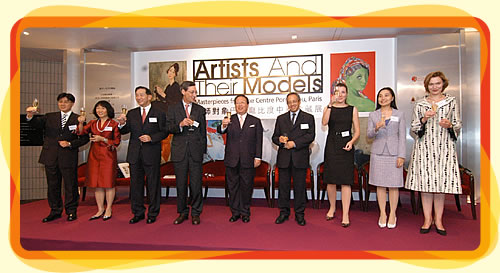 |
The opening ceremony of the exhibition Artists and Their Models — Masterpieces from the Centre Pompidou, Paris. |
|
 |
The World of the Etruscans on display at the Hong Kong Museum of Art. |
|
To fulfil its educational functions and mission, the Museum also took an active part in various art education and extension programmes such as the International Museum Day 2006, School Culture Day, International Arts Carnival 2006 and a wide range of in-house programmes such as lectures, art demonstrations and workshops and video shows. The exhibitions, together with various education and extension programmes, attracted over 410 000 visitors and participants during the year.
Flagstaff House Museum of Tea Ware
Situated in Hong Kong Park, the Flagstaff House Museum of Tea Ware is a branch of the Hong Kong Museum of Art that is devoted to the display of Chinese tea ware and the promotion of tea culture.
Two special exhibitions were held in 2006. Tea Ware by Hong Kong Potters 2005 illustrated outstanding tea-drinking vessels that were created by local potters. Poetry and Ceramic Art: Collection of the Hong Kong Museum of Art and the K.S. Lo Collection of the Flagstaff House Museum of Tea Ware featured refined ceramics and tea poetry dating from the Tang dynasty to the 20th century. The exhibitions, together with the education and extension activities, attracted over 212 800 visitors during the year.
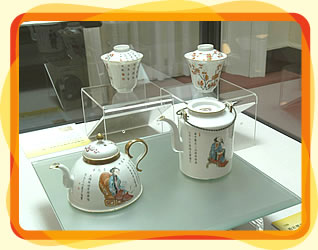 |
Traditional Chinese tea ware from the exhibition Poetry and Ceramic Art: Collection of the Hong Kong Museum of Art and the K.S. Lo Collection of the Flagstaff House Museum of Tea Ware. |
|
Hong Kong Museum of History
The Hong Kong Museum of History makes a concerted effort to collect, preserve and display cultural objects that are closely related to the history of Hong Kong and the South China area. The functions of the Museum are four-fold — to be an educational, cultural/exhibition, research and conservation centre to enhance public awareness and understanding of the history and culture of China and Hong Kong with a view to enriching cultural lives, strengthening social cohesion and nurturing national identity. With rich collections, research work on different projects, digitalisation of information and interaction with Chinese and overseas institutions, the Museum is dedicated to fulfilling its educational and cultural roles in society.
The Museum continued to maintain close collaboration with museums and cultural institutions and, in addition to the permanent exhibition, The Hong Kong Story, presented various thematic exhibitions with museums from Mainland China and overseas, including Sailing West: Admiral Zheng He's Voyages, From Bones to Bytes: Chinese Script Decoded, Dr Sun Yat-sen in Paper-cut Silhouette and Football. These joint presentations not only broadened the cultural horizons of the general public, but also facilitated the academic and cultural interflow among Hong Kong, Mainland China and overseas. In addition, the Museum continued its collaboration with government departments, non-profit-making institutions and artists to present a number of exhibitions, including Historical Memorabilia of a Distinguished Civil Service, Documentary of Child Development — Footprints of Children from the 1930s to 2006 and A Nostalgic Touch: Exhibition on Kong Kai Ming Collection. In these exhibitions, different facets of life, local history and cultural heritage were depicted. The Museum attracted 581 329 visitors during the year.
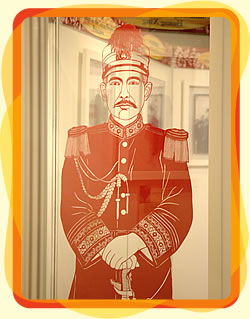 |
A delicate paper-cut work of Dr Sun Yat-sen by Lu Xue, a famous Chinese paper-cut artist. |
|
To foster public interest in local history and cultural heritage, the Museum also organised a rich variety of education and extension activities such as lectures, workshops, training courses for teachers, guided tours and field visits to historic sites. Highlights of the year include the International Conference on the History and Culture of the British Concession in China during the Late Qing Period, which was organised in Weihai, Shandong Province, and the International Conference in Commemoration of the Centennial Birthday of the Late Professor Lo Hsiang-lin, which was presented in Hong Kong.
The Dr Sun Yat-sen Museum, a branch of the Museum of History, opened in December with the presentation of two permanent exhibitions, Dr Sun Yat-sen and Modern China and Hong Kong in Sun Yat-sen's time.
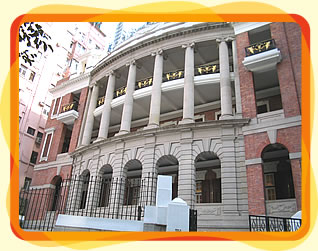 |
The Dr Sun Yat-sen Museum is one of the new tourist attractions in Hong Kong.
 (Upper) The majestic exterior of the Dr Sun Yat-sen Museum. (Upper) The majestic exterior of the Dr Sun Yat-sen Museum.
(Lower) The statue of Dr Sun Yat-sen. |
|
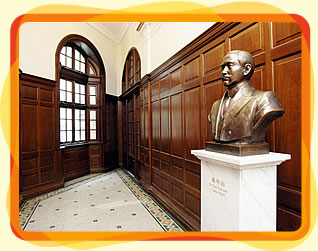 |
In addition to the Hong Kong Museum of Coastal Defence and Dr Sun Yat-sen Musuem, the Museum of History also manages two other branch museums, the Lei Cheng Uk Han Tomb Museum in Sham Shui Po and the Law Uk Folk Museum in Chai Wan, attracting 58 548 and 22 023 visitors, respectively.
Hong Kong Museum of Coastal Defence
Converted from the old Lei Yue Mun Fort in Shau Kei Wan, the Hong Kong Museum of Coastal Defence occupies about 34 000 square metres and its permanent exhibition, 600 Years of Hong Kong's Coastal Defence in Hong Kong, depicts Hong Kong's history of coastal defence from the Ming and Qing dynasties, British period, and Japanese invasion to the period after Hong Kong's reversion to Chinese sovereignty. Thematic exhibition galleries stage displays on topics related to the military history and defence of Hong Kong. Visitors may also explore military relics in the Redoubt and on the Historical Trail, such as gun batteries, a torpedo station, caponiers and magazines.
Throughout the year, four thematic exhibitions were presented, namely, Archery Traditions of Asia, The 8-year War of Resistance, Ancient Chinese Weapons and Fujian Arsenal: Cradle of Modern Chinese Navy. In addition, a symposium on Ancient Chinese Military History and the Thoughts of Sun Zi was held in March with the participation of over 80 academics and experts from mainland China, Taiwan, Hong Kong and abroad. Diverse education activities such as lectures on specific topics, family workshops, demonstrations, drill performances and field visits to military sites were organised. The Museum attracted 161 896 visitors during the year.
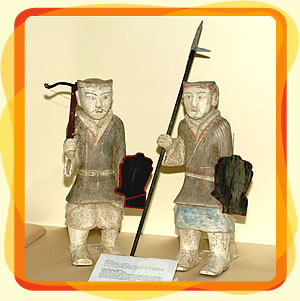 |
A pair of pottery figurines from the Ancient Chinese Weapons exhibition. |
|
Hong Kong Science Museum
The mission of the Hong Kong Science Museum is to promote public interest in science and technology and develop into a science centre of international standards. The Museum also strives to establish a good collection of artefacts on science and technology for research, education and appreciation by the general public.
Notable exhibitions of the year included Optical Illusion, Genomic Revolution and Mission Earthling. The Genomic Revolution exhibition examined the extraordinary developments taking place in the field of genomics and explored their impact on science and our everyday lives. Mission Earthling depicted various human body systems through the eyes of visiting aliens. Two dozen interactive exhibits allowed visitors to explore the structure, function and adaptation of the human body.
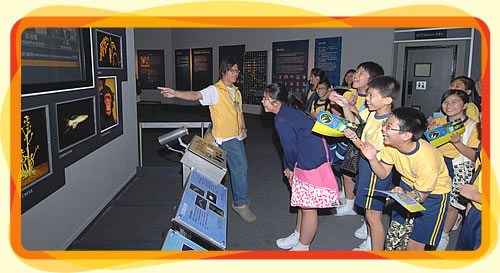 |
Students compare the human genome with the genome of other organisms in the We Are All Alike exhibit of the Genomic Revolution exhibition. They are surprised to learn that humans and chimpanzees have 95 per cent of genes in common. |
|
Children squeeze food through intestine models in the Fibre Factor exhibit of the Mission Earthling exhibition, where they learn that a high-fibre diet is important for a healthy digestive system. |
|
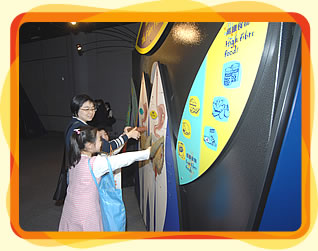 |
The Museum celebrated its 15th anniversary. A series of special activities was organised for different groups and family visitors. For the exhibit Photo Collection Campaign, members of the public were invited to submit photos of their prior visits to the Museum for assemblage into a mosaic for the Science Museum. The photo mosaic was on display in the museum lobby as part of a special exhibition titled From Aspiration to Achievements from April to May. Other major programmes included Science Fest and Bubble Magic Show, My Favourite Scientists Election, Leading Scholars Lecture Series, and Our Birthday Parties and Science Talk for students. More than 9 500 participants took part in the above activities.
Jointly organised by the Museum, the China Association for Science and Technology, the Beijing — Hong Kong Academic Exchange Centre and the China Association (HK) for Science and Society Ltd, the Distinguished Chinese Scientists Lecture Series 2006 invited renowned scientists from Mainland China and Hong Kong to deliver lectures. In mid-November, Science Alive 2006 was hosted by the Museum. The programme was jointly presented by the British Council and the Education and Manpower Bureau and sponsored by the Croucher Foundation. A series of lectures and workshops were conducted through a lively and interactive approach. In addition, science drama performances were arranged for primary school students. A Science Alive exhibition was on display in the museum lobby for two weeks for school groups and museum visitors.
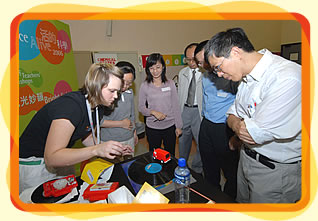 |
Impressive demonstrations at the Science Alive 2006 teacher workshop. |
|
To encourage the creativity of local artists in the design of weather-related sculpture, the Weather Machines Kinetic Sculpture Design Competition was organised. Two winning entries from the competition were commissioned for production and installation in the piazza. The sculpture Singing in the Rain was completed and unveiled on April 18, 2006, in celebration of the 15th anniversary of the Science Museum. The other sculpture, Whistling Aloft, is in progress and will be completed in 2007.
Throughout the year, the Museum worked with academic institutions and professional bodies on a number of special projects to promote science to society. Among the projects were the Fun Science Competition, Robotic Olympiads and 39th Joint School Science Exhibition.
In 2006, the exhibitions and extension activities of the Museum attracted 797 975 visitors and participants.
Hong Kong Space Museum
The Hong Kong Space Museum officially opened in October 1980 and is a major institution dedicated to the popularisation of astronomy and space science in Hong Kong. The Museum comprises two exhibition halls and the Stanley Ho Space Theatre. The 59 groups of exhibits are predominantly interactive to enable visitors to learn while having fun. The Theatre's 23-metre hemispherical screen provides the audience with the stunning and true-to-life visual impact of Omnimax films.
With the demotion of Pluto to a new category of Solar System Objects known as dwarf planets at the General Assembly of the International Astronomical Union (IAU) in August 2006, a temporary exhibition — The New Definitions of Planets and a new exhibit — Exploring the Solar System — were developed to address the latest controversy surrounding Pluto's status from a scientific perspective. Providing a wealth of useful information and educational resources on stargazing and basic astronomy, the Museum's homepage (http://hk.space.museum) remained as popular as ever, and had a cumulative hit rate of 6 464 971 by the end of the year.
In June 2006, Professor Stephen Hawking visited Hong Kong, and the book Chinese Ancient Star Maps produced by the Museum was selected as a souvenir for presentation to the internationally acclaimed scientist. During the year, the Museum published Astrocalendar 2007 and presented two Sky Shows, four Omnimax Shows and four School Shows. Together, these programmes attracted 332 531 viewers. In addition, 19 596 members of public joined the 168 extension activities organised by the Museum while 351 445 visited the twelve temporary special exhibitions as well as the Hall of Astronomy and Hall of Space Science.
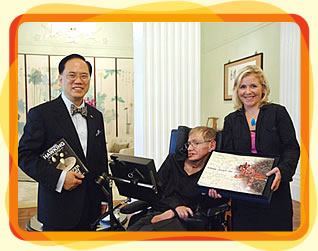 |
Chief Executive Donald Tsang (left) presents Chinese Ancient Star Map, a publication of the Hong Kong Space Museum, to Professor Stephen Hawking (middle) as a souvenir during Professor Hawking's visit to Hong Kong. |
|
Hong Kong Heritage Museum
Leisure and Entertainment was the theme of the Museum's programmes in 2006. To explore the theme from various angles, special exhibitions entitled Enlightening Trivialities — Ancient Chinese Pastimes, Hong Kong's Popular Entertainment, Mega Crossover — 4 X Home, MEGartSTORE, The Fun of Collecting and Better Living — Product Design Contributes were presented. Featuring 115 artefacts from the National Museum of China, Ancient Chinese Pastimes presented a great variety of ancient Chinese forms of recreation. Hong Kong's Popular Entertainment traced the changes of Hong Kong's major leisure activities over the past 100 years. 4 X Home invited four local creative talents from different disciplines to create home designs. MEGartSTORE showcased 300 works of art in a shopping mall environment with the participation of local artists, architects and designers. Better Living featured successful products and experimental works by both renowned and up-and-coming local product designers and The Fun of Collecting presented the unique collections of four local collectors.
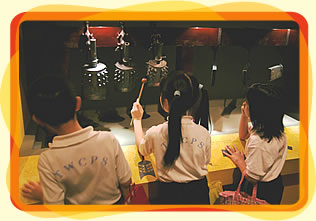 |
Students strike replicas of chang xin chime bells and stone chimes at the exhibition Enlightening Trivialities — Ancient Chinese Pastimes. |
|
The exhibition Hong Kong's Popular Entertainment leads visitors through the evolution of the childhood companions of Hong Kong people. |
|
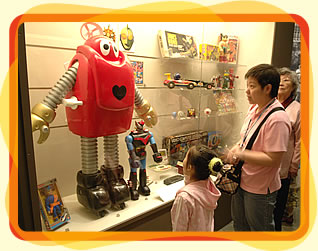 |
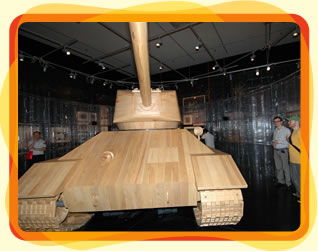 |
'A Bleeding Toy from Childhood' by Amy Cheung at the MEGartSTORE exhibition. |
|
A wide variety of educational and extension activities such as seminars, lectures, field trips, performances, demonstrations, art camps, workshops and competitions was organised during the year. A new initiative for secondary school students known as MuseTeens: Youth Leadership Scheme was introduced in mid-2006. A series of training programmes was carried out under the scheme which successfully stimulated an awareness of and interest in local heritage among participants.
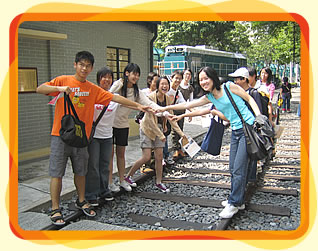 |
Sixty secondary school students selected as the MuseTeens enjoy a wonderful day at the Hong Kong Railway Museum. |
|
The exhibition programmes, together with the educational and extension activities, attracted more than 510 000 visitors and participants in 2006.
The Heritage Museum manages three branch museums — the Sam Tung Uk Museum, Hong Kong Railway Museum and Sheung Yiu Folk Museum. Together, they attracted 520 000 visitors during the year.
Hong Kong Film Archive
The core function of the Film Archive is to acquire, preserve, catalogue and document Hong Kong films and related materials. With a gross floor area of 7 200 square metres, the Archive's major facilities include a cinema, an exhibition hall, a resource centre and four temperature-controlled collection stores. It has already acquired more than 6 300 films and 786 000 items of related materials, mainly through donations and deposits. Major acquisitions this year included the donation of 199 Shaw Studio films from Celestial Pictures Ltd.
 |
Members of the public take advantage of the resources offered by the resource centre of the Hong Kong Film Archive. |
|
The Archive continued its efforts in film research and conducted oral history interviews with film veterans. Several publications including the Oral History Series (3): Director Chor Yuen, @Location, The Glorious Modernity of Kong Ngee and Frame After Frame were published during the year.
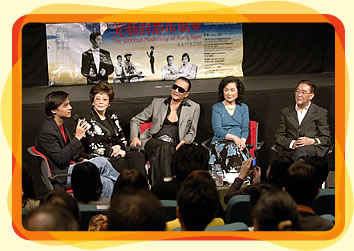 |
Stars including (second from left to right) Kar Ling, Tse Yin, Nam Hung and Chow Chung recall their days at Kong Ngee at the seminar 'The Kong Ngee Star Shines Again' at the Hong Kong Film Archive. |
|
The Archive also collaborated with other cultural organisations and overseas archives to cultivate the public's appreciation of cinematic arts. During the year, eight thematic exhibitions, including @Location, Frame After Frame and The Glorious Modernity of Kong Ngee, etc., were organised with supporting screenings and seminars. The resource centre, equipped with computers, video booths and a rich collection of film-related reading materials, is well patronised by the public. In 2006, the Archive attracted over 216 300 visitors.
Art Promotion Office
The core function of the Office is to bring the visual arts into everyone's life through the continual nurturing of the public's interest in and ability to appreciate art and creation. To pursue its mission, the Office offers various programmes in public and community art. Through proactive approaches and channels, the Office has successfully built up partnerships with various arts organisations, government departments and private sector members to jointly organise visual art projects.
Public Art Scheme 2006 aimed to embellish three LCSD venues, namely, the Hong Kong Heritage Discovery Centre at Kowloon Park, Tsim Sha Tsui, Ko Shan Road Park at To Kwa Wan, and Po Hong Park at Tseung Kwan O, through open competition to install artwork on site. The Call for Entries was announced in November. The winning artwork proposals will be shown in exhibition in May 2007 and the artists will receive a commission offer. The Mobile Art Expedition was a partnership project with the Hong Kong Arts Development Council, New World First Bus Services Limited, New World First Ferry Services Limited and Citybus Limited. Artwork was selected through an open competition and the different pieces were reproduced for display for six months in bus compartments and at Pier 5 in Central. The exhibition finished in June with a record attendance figure of 47 440. In addition, the project New Face of Heritage — Installation of Public Artwork at Yat Tung Estate, Tung Chung, Stage Two, jointly organised by the LCSD and the Housing Department, was completed, with 10 outdoor works of art being commissioned and installed in the public estate in Tung Chung. An inauguration ceremony was held on November 11, 2006, to celebrate the completion of the artwork. Together with the sculptures of stage one of the project, a beautiful art walk characterised by 26 works of art was formed for the first time in a public estate.
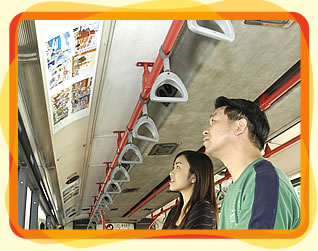 |
Members of the public enjoy the artwork of the Mobile Art Expedition exhibition installed inside a bus. |
|
Yat Tung Estate becomes a unique housing estate with the installation of 26 outdoor sculptures commissioned under the New Face of Heritage — Installation of Public Artwork at Yat Tung Estate, Tung Chung project. |
|
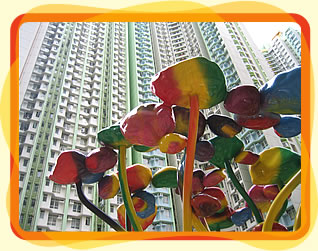 |
A major community art scheme, Artists in the Neighbourhood Scheme III, was carried out during the year. Through the display of the latest work by outstanding local artists in various districts, the public were able to appreciate art in their daily lives. Fourteen roving exhibitions were set up to display the work of eight selected artists at various venues of the Department and venues of partners, namely, KCR East Tsim Sha Tsui Station, the Hong Kong Arts Centre, Xinhua Book City, Stanley Plaza, Yat Tung Shopping Centre and Lung Cheung Mall.
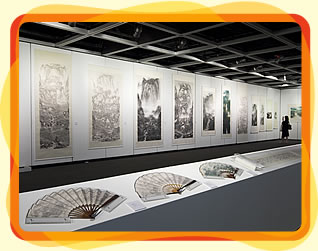 |
A view of the Artists in the Neighbourhood Scheme III: Traditional into Contemporary — The Art of Hung Hoi at the Exhibition Hall of Hong Kong City Hall. |
|
Hong Kong Visual Arts Centre
The Hong Kong Visual Arts Centre, with nine art studios, a lecture theatre, an exhibition hall and a multipurpose room, focuses on training in the visual arts, promotion and the provision of facilities for professionals to hire. The fifth Art Specialist Course, which covered five disciplines — ceramics, printmaking, painting, sculpture and ink painting, was designed for art lovers who want to pursue structured professional art training. A graduation exhibition was planned for early 2007 to mark the completion of the nine-month course and give recognition to the efforts of the 50 graduates. To support and promote the development of Hong Kong art, the Centre organised a series of Artist in Residence programmes during the year to invite the participation of the award-winning artists of the Hong Kong Art Biennial 2005. In addition to the various associated educational activities, two exhibitions, Traces of Tranquillity — The Calligraphy of Fung Yat-fung and I/O FLOWS — A Sound Installation by Cedric Maridet, were held in September and November, respectively.
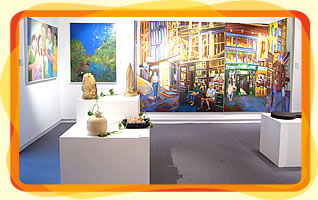 |
A view of the Art Specialist Course 2006-07 Graduation Exhibition at the Hong Kong Visual Arts Centre. |
|

|




















